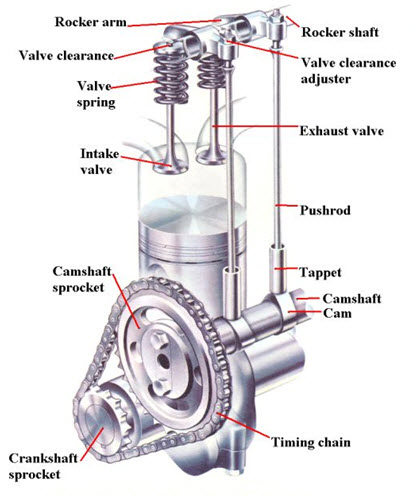Site pages
Current course
Participants
General
Module 1. Classification of Farm Power Sources
Module 2. Classification of IC Engines & Therm...
Module 3. Performance Characteristics
Module 4. Engine Components
Module 5. Engine Operating System
Module 6.:Engine Fuel System
Module 7. Engine Governor
Module 8. Engine Cooling & Lubrication system
Module 9. Engine Ignition System
LESSON 11. Valve Mechanism
11.1 Need
Engine valves are used in engines to allow air or air-fuel mixture to enter into the cylinder (through inlet valve) and also to push exhaust gases (through outlet valve) from the cylinder at a specific time during the engine cycle. To have complete contact between the valve and engine surface (head), an accurately faced surface is provided which is known as valve seat. For inlet valves. the seat surface is directly machined on the engine head and are also known as integral seats. However, special seat inserts are used for exhaust valves as these are continuously exposed high temperature and thermal stress.
The stem of the valve needs to move up and down without any deviation from its axis. Since, these stems are subjected to side thrust also, the valve guides are provided to maintain its alignment. Sometimes, these guides are the direct holes in the engine block. However, separate valve guides have also been used as inserts which are cylindrical in shape. The clearance between the valve stem and guide is kept optimum/sufficient to maintain lubrication film around the stem surface.

Valve spring (helical) are used to keep valve in regular contact with the tappet and the tappet with the cam. These valve springs should be fatigue resistant and are made up of high grade spring steel wire, hard-drawn steel or chrome-vanadium steel.
11.2 Valve actuation
A complete mechanism is involved in actuating the inlet and exhaust valves (opening & closing) through the motion of different components come in valve train. A cam is used as a drive to actuate the valve and this cam rotates at half of the speed of crankshaft in a four stroke engine. Following are the various components of valve train.
i) Camshaft
ii) Tappet
iii) Push rod
iv) Rocker arm
v) Valves
Camshaft : Camshaft is a shaft in which cams are provided as integral part of the shaft. Separate cam is provided for each valve (inlet and exhaust). Cam has it path profile having high spot known as nose and the lowest point termed as base. These two points nose and base corresponds to fully opened and closing of valves respectively. The cam profile is provided to have smooth rise (opening) and fall (closing) of valves. The cam is a rotating element which generates the reciprocating motion to the follower which is known as push rod in a plane at right angle to the cam axis. Cam shaft is also used to drive fuel pump. Camshaft is made up of forged alloy steel which is case hardened.
Tappet : This is also known as cam follower or valve lifter which follows the shape of the cam to provide reciprocating motion to the valves by conversing angular/rotating motion of the cam shaft. The tappet is placed in between the cam and the push rod which helps in preventing the side thrust to be exerted from the cam on the push rod. Some clearance is provided between the cam and tappet to take care of thermal expansion and this clearance is known as valve lash.
Push rod : The reciprocating motion of the push rod actuates the rocker arm which moves in an arc about its pivot. Push rods are made of carbon-manganese steel.
Rocker arm : The rocker arm is used to convert the upward movement of push rod to the downward movement of the valve (opening up) and also the downward movement of pushrod to upward movement of valve (closing down). The rocker arm can be made of either hollow or solid material. The rocker arms are pivoted to rocker shaft which also provides lubrication
Valves : Although various types of valves are available but poppet valves are the most commonly used engines valves being used in engines these days. These poppet valves are also known as mushroom valves as its shape resembles to the mushroom having head and stem. Generally, inlet valves are larger in size to enhance the air intake and exhaust valves are made relatively harder than the inlet valves as these are exposed to hot exhaust gases always. Exhaust valves are made up of special material i.e austenitic steels and precipitation hardening steel which should have high strength to resist tensile loads, wear resistance due to heat, corrosion resistance, low coefficient of thermal expansion and high thermal conductivity. Since, the valve temperature reaches to several hundred (7500C), valve cooling is also essential for which valve stems are sometimes filled with sodium (which has high thermal conductivity).